A Heuristic Algorithm for Combined Heat and Power System Operation Management
Abstract
1. Introduction
Contributions
- A fast heuristic algorithm for single CHP plant to address residential CHP-ED problems. The main idea here is to decompose the problem into three parts: electrical, domestic hot water, and heat demands. Then, a suitable heuristic is designed to combine them:
- A linear single CHP algorithm incorporating thermal and electrical demands and a holistic model for capturing the interactions among energy vectors in a building.
- Illustrating the proposed heuristics on a nano-cogenerator and multi-energy systems in a building.
2. Literature Review
3. System Description and Modeling
3.1. Nano Co-Generation Unit
3.2. Electrical Storage System
3.3. Heat Exchanger
3.4. Thermal Storage System
3.5. Heat Pump
3.6. Heat Pump Shunting between Heat Exchanger and Thermal Energy Storage
3.7. Power Balance
4. Proposed Heuristics Formulation
- When should each equipment be switched on or off, and how much should it produce?
- When should the electric and thermal storage be charged or discharged?
4.1. Heuristic Algorithm Module for Heat Demand Satisfaction
- Step 1
- The heat demand is first compared with the thermal energy stored in TES, by checking .
- Step 2
- In case is not achievable with the available only, the algorithm is designed to set to ON state, connecting HE with the TES so that both thermal storage are used.
- Step 3
- If can not be satisfied even with HE and TES, the heat pump will be set to its ON state to cover the mismatch between the and the available thermal energy in the storage.
- Step 4
- If the is not achieved with the available thermal power from heat pump, and thermal storage, the controller set the thermal resistor to ON state ().
- Step 5
- As a last resort, if at a certain time is so large it can not be satisfied with the storage, the generation units, the thermal resistor, and the heat pump, the CHP will be set to ON state to meet the requested heat demand.
4.2. Heuristic Algorithm Module for Hot Water Demand Satisfaction
- Step 1
- The hot water demand is first compared with the thermal solar panel generation , and the thermal energy stored in HE, by checking .
- Step 2
- If is not achievable with the available , and , the heat pump is set to ON state so that the additional thermal power is shunted towards HE to meet the required .
- Step 3
- If is not achieved with the available thermal power from heat pump and thermal storage, the controller sets the thermal resistor to ON state ().
- Step 4
- In case is achievable through the available energy from generation, storage, heat pump, and thermal resistor, the fuel cost of the CHP would be saved. Contrarily, CHP will be ON to fulfill the demand as a last resort.
4.3. Heuristic Algorithm Module for Electric Demand Satisfaction
- Step 1
- At each time k, the available is first checked in order to meet electric demand , as well as the power needed to charge to its maximum level.
- Step 2
- In the second step, is compared with the electric demand only. If cannot be satisfied with it, the batteries act as a backup source in order to satisfy the power balance equation.
- Step 3
- In case cannot be met with the renewable sources as well as with the battery , then the CHP is switched ON in order to meet that electric demands.
5. A GA-Solved Optimization Problem for Benchmarking
- Step 1
- Read the electric and thermal power requests, maximum number of iterations, and population size.
- Step 2
- Generate an initial population . The chromosomes length is equal to the number of decision variables in Equation (17).
- Step 3
- Check the constraints that correspond to the individuals in . Infeasible solutions are then removed from the solution space through the assignment of a large penalty cost.
- Step 4
- Evaluate the “fitness function” for individuals in using the objective function in Equation (18). The population is then indexed by the iteration number i (i.e., population = ).
- Step 5
- Generate a new pool of candidate solution through the application of the operators selection, crossover, and mutation to [42].
- Step 6
- Check the constraints formulation for all the individuals mentioned in .
- Step 7
- Evaluate the objective function for all the individuals listed in . The less constraint-violating solutions from and will be retained.
- Step 8
- If the solution with the best objective value remains unchanged for a significant number of iterations, the algorithm goes to report the results at step 9, if not, it goes to step 5.
- Step 9
- Report the results.
6. Simulations and Numerical Results
6.1. Simulation Setup
6.2. Test Runs
6.3. Example 1
6.3.1. Heat Demand Satisfaction
6.3.2. Hot Water Demand Satisfaction
6.3.3. Electric Demand Satisfaction
6.3.4. Water Pumps
6.4. Example 2
6.4.1. Heat Demand Satisfaction
6.4.2. Hot Water Demand Satisfaction
6.4.3. Electric Demand Satisfaction
6.4.4. Water Pumps
6.5. Algorithms Comparison
7. Conclusions
Author Contributions
Funding
Institutional Review Board Statement
Informed Consent Statement
Data Availability Statement
Conflicts of Interest
References
- Caliano, M.; Bianco, N.; Graditi, G.; Mongibello, L. Economic optimization of a residential micro-CHP system considering different operation strategies. Appl. Therm. Eng. 2016, 101, 592–600. [Google Scholar] [CrossRef]
- Yu, H.; Nord, L.O.; Yu, C.; Zhou, J.; Si, F. An improved combined heat and power economic dispatch model for natural gas combined cycle power plants. Appl. Therm. Eng. 2020, 181, 115939. [Google Scholar] [CrossRef]
- Qaeini, S.; Nazar, M.S.; Varasteh, F.; Shafie-khah, M.; Catalão, J.P. Combined heat and power units and network expansion planning considering distributed energy resources and demand response programs. Energy Convers. Manag. 2020, 211, 112776. [Google Scholar] [CrossRef]
- Pourghasem, P.; Sohrabi, F.; Abapour, M.; Mohammadi-Ivatloo, B. Stochastic multi-objective dynamic dispatch of renewable and CHP-based islanded microgrids. Electr. Power Syst. Res. 2019, 173, 193–201. [Google Scholar] [CrossRef]
- Neyestani, M.; Hatami, M.; Hesari, S. Combined heat and power economic dispatch problem using advanced modified particle swarm optimization. J. Renew. Sustain. Energy 2019, 11, 015302. [Google Scholar] [CrossRef]
- Ahmadi, P.; Almasi, A.; Shahriyari, M.; Dincer, I. Multi-objective optimization of a combined heat and power (CHP) system for heating purpose in a paper mill using evolutionary algorithm. Int. J. Energy Res. 2012, 36, 46–63. [Google Scholar] [CrossRef]
- Olatomiwa, L.; Mekhilef, S.; Ismail, M.; Moghavvemi, M. Energy management strategies in hybrid renewable energy systems: A review. Renew. Sustain. Energy Rev. 2016, 62, 821–835. [Google Scholar] [CrossRef]
- Maleki, A.; Rosen, M.A. Design of a cost-effective on-grid hybrid wind–hydrogen based CHP system using a modified heuristic approach. Int. J. Hydrogen Energy 2017, 42, 15973–15989. [Google Scholar] [CrossRef]
- Barbieri, E.S.; Melino, F.; Morini, M. Influence of the thermal energy storage on the profitability of micro-CHP systems for residential building applications. Appl. Energy 2012, 97, 714–722. [Google Scholar] [CrossRef]
- Larissa, B.; Maran, R.M.; Ioan, B.; Anca, N.; Mircea-Iosif, R.; Horia, T.; Gheorghe, F.; Ema Speranta, M.; Dan, M.I. Adjusted net savings of CEE and Baltic nations in the context of sustainable economic growth: A panel data analysis. J. Risk Financ. Manag. 2020, 13, 234. [Google Scholar] [CrossRef]
- Ioan, B.; Malar Kumaran, R.; Larissa, B.; Anca, N.; Lucian, G.; Gheorghe, F.; Horia, T.; Ioan, B.; Mircea-Iosif, R. A panel data analysis on sustainable economic growth in India, Brazil, and Romania. J. Risk Financ. Manag. 2020, 13, 170. [Google Scholar] [CrossRef]
- Rose, S.K.; Richels, R.; Blanford, G.; Rutherford, T. The Paris Agreement and next steps in limiting global warming. Clim. Chang. 2017, 142, 255–270. [Google Scholar] [CrossRef]
- Casals, L.C.; Martinez-Laserna, E.; García, B.A.; Nieto, N. Sustainability analysis of the electric vehicle use in Europe for CO2 emissions reduction. J. Clean. Prod. 2016, 127, 425–437. [Google Scholar] [CrossRef]
- Acke, D. Zeroing In: Lessons from the European Climate Foundation’s Roadmap 2050 Project. IEEE Power Energy Mag. 2014, 12, 42–49. [Google Scholar] [CrossRef]
- Boden, T.A.; Marland, G.; Andres, R.J. Global, Regional, and National Fossil-Fuel CO2 Emissions; Carbon Dioxide Information Analysis Center, Oak Ridge National Laboratory, US Department of Energy: Oak Ridge, TN, USA, 2009; Volume 10. [CrossRef]
- Sgobba, A.; Meskell, C. On-site renewable electricity production and self consumption for manufacturing industry in Ireland: Sensitivity to techno-economic conditions. J. Clean. Prod. 2019, 207, 894–907. [Google Scholar] [CrossRef]
- Kosmadakis, G. Estimating the potential of industrial (high-temperature) heat pumps for exploiting waste heat in EU industries. Appl. Therm. Eng. 2019, 156, 287–298. [Google Scholar] [CrossRef]
- Capizzi, F.; Das, A.; Dauwe, T.; Moorkens, I.; Juhana, R. Renewable Energy in Europe—2019; European Environmental Agency-European Topic Centre on Climate Change Mitigation and Energy: Mol, Belgium, 2019. [Google Scholar]
- Sun, J.; Li, Y. Social cognitive optimization with tent map for combined heat and power economic dispatch. Int. Trans. Electr. Energy Syst. 2019, 29, e2660. [Google Scholar] [CrossRef]
- Steen, D.; Stadler, M.; Cardoso, G.; Groissböck, M.; DeForest, N.; Marnay, C. Modeling of thermal storage systems in MILP distributed energy resource models. Appl. Energy 2015, 137, 782–792. [Google Scholar] [CrossRef]
- Li, Y.; Wang, J.; Zhao, D.; Li, G.; Chen, C. A two-stage approach for combined heat and power economic emission dispatch: Combining multi-objective optimization with integrated decision making. Energy 2018, 162, 237–254. [Google Scholar] [CrossRef]
- Wouters, C.; Fraga, E.S.; James, A.M. An energy integrated, multi-microgrid, MILP (mixed-integer linear programming) approach for residential distributed energy system planning—A South Australian case-study. Energy 2015, 85, 30–44. [Google Scholar] [CrossRef]
- Rafique, M.K.; Haider, Z.M.; Mehmood, K.K.; Saeed Uz Zaman, M.; Irfan, M.; Khan, S.U.; Kim, C.H. Optimal Scheduling of Hybrid Energy Resources for a Smart Home. Energies 2018, 11, 3201. [Google Scholar] [CrossRef]
- Sanguinetti, A.; Karlin, B.; Ford, R.; Salmon, K.; Dombrovski, K. What’s energy management got to do with it? Exploring the role of energy management in the smart home adoption process. Energy Effic. 2018, 11, 1897–1911. [Google Scholar] [CrossRef]
- Ford, R.; Pritoni, M.; Sanguinetti, A.; Karlin, B. Categories and functionality of smart home technology for energy management. Build. Environ. 2017, 123, 543–554. [Google Scholar] [CrossRef]
- Lin, C.; Wu, W.; Zhang, B.; Sun, Y. Decentralized solution for combined heat and power dispatch through benders decomposition. IEEE Trans. Sustain. Energy 2017, 8, 1361–1372. [Google Scholar] [CrossRef]
- Sashirekha, A.; Pasupuleti, J.; Moin, N.; Tan, C.S. Combined heat and power (CHP) economic dispatch solved using Lagrangian relaxation with surrogate subgradient multiplier updates. Int. J. Electr. Power Energy Syst. 2013, 44, 421–430. [Google Scholar] [CrossRef]
- Yokoyama, R.; Shinano, Y.; Wakayama, Y.; Wakui, T. Model reduction by time aggregation for optimal design of energy supply systems by an MILP hierarchical branch and bound method. Energy 2019, 181, 782–792. [Google Scholar] [CrossRef]
- Nazari-Heris, M.; Mohammadi-Ivatloo, B. Application of heuristic algorithms to optimal PMU placement in electric power systems: An updated review. Renew. Sustain. Energy Rev. 2015, 50, 214–228. [Google Scholar] [CrossRef]
- Kim, J.S.; Edgar, T.F. Optimal scheduling of combined heat and power plants using mixed-integer nonlinear programming. Energy 2014, 77, 675–690. [Google Scholar] [CrossRef]
- Pattanaik, J.K.; Basu, M.; Dash, D.P. Heat Transfer Search Algorithm for Combined Heat and Power Economic Dispatch. Iran. J. Sci. Technol. Trans. Electr. Eng. 2020, 44, 963–978. [Google Scholar] [CrossRef]
- Nguyen Trung, T.; Vo Ngoc, D. Improved particle swarm optimization for combined heat and power economic dispatch. Sci. Iran. 2016, 23, 1318–1334. [Google Scholar] [CrossRef]
- Allegrini, J.; Orehounig, K.; Mavromatidis, G.; Ruesch, F.; Dorer, V.; Evins, R. A review of modelling approaches and tools for the simulation of district-scale energy systems. Renew. Sustain. Energy Rev. 2015, 52, 1391–1404. [Google Scholar] [CrossRef]
- Alomoush, M.I. Optimal Combined Heat and Power Economic Dispatch Using Stochastic Fractal Search Algorithm. J. Mod. Power Syst. Clean Energy 2020, 8, 276–286. [Google Scholar] [CrossRef]
- Nazari-Heris, M.; Mehdinejad, M.; Mohammadi-Ivatloo, B.; Babamalek-Gharehpetian, G. Combined heat and power economic dispatch problem solution by implementation of whale optimization method. Neural Comput. Appl. 2019, 31, 421–436. [Google Scholar] [CrossRef]
- Maleki, A.; Rosen, M.A.; Pourfayaz, F. Optimal operation of a grid-connected hybrid renewable energy system for residential applications. Sustainability 2017, 9, 1314. [Google Scholar] [CrossRef]
- Vögelin, P.; Koch, B.; Georges, G.; Boulouchos, K. Heuristic approach for the economic optimisation of combined heat and power (CHP) plants: Operating strategy, heat storage and power. Energy 2017, 121, 66–77. [Google Scholar] [CrossRef]
- Celador, A.C.; Odriozola, M.; Sala, J. Implications of the modelling of stratified hot water storage tanks in the simulation of CHP plants. Energy Convers. Manag. 2011, 52, 3018–3026. [Google Scholar] [CrossRef]
- Deb, K. Multi-Objective Optimization Using Evolutionary Algorithms; John Wiley & Sons: Hoboken, NJ, USA, 2001; Volume 16. [Google Scholar]
- Goldberg, D.E. Genetic Algorithms; Pearson Education: Tamil Nadu, India, 2006. [Google Scholar]
- Dan, M.; Srinivasan, S.; Sundaram, S. A Hybrid Cross-Entropy Guided Genetic Algorithm for Scheduling Multi-Energy Systems. In Proceedings of the 2018 IEEE Symposium Series on Computational Intelligence (SSCI), Bangalore, India, 18–21 November 2018; pp. 1807–1814. [Google Scholar]
- Suresh, S.; Huang, H.; Kim, H.J. Hybrid real-coded genetic algorithm for data partitioning in multi-round load distribution and scheduling in heterogeneous systems. Appl. Soft Comput. 2014, 24, 500–510. [Google Scholar] [CrossRef]
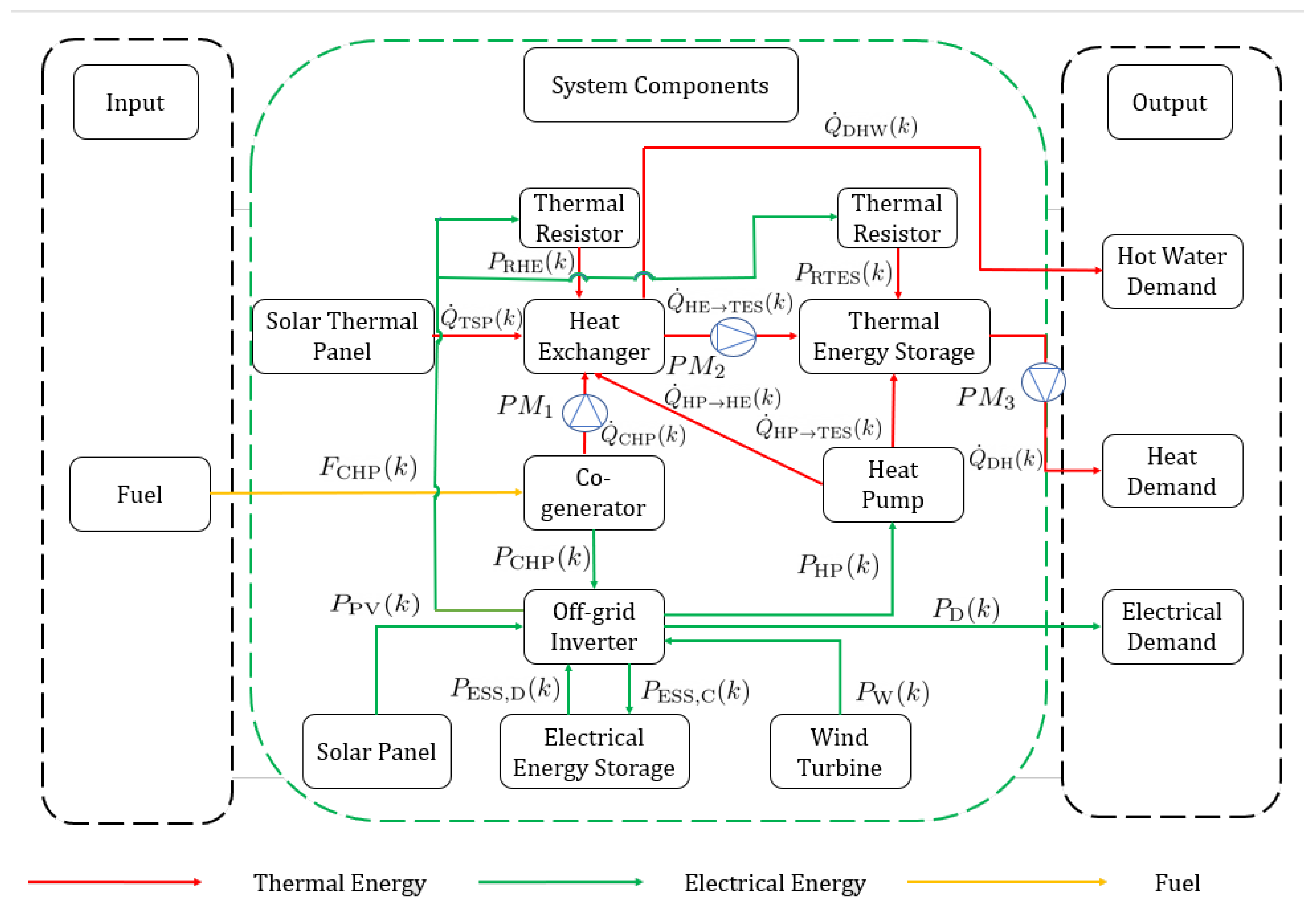

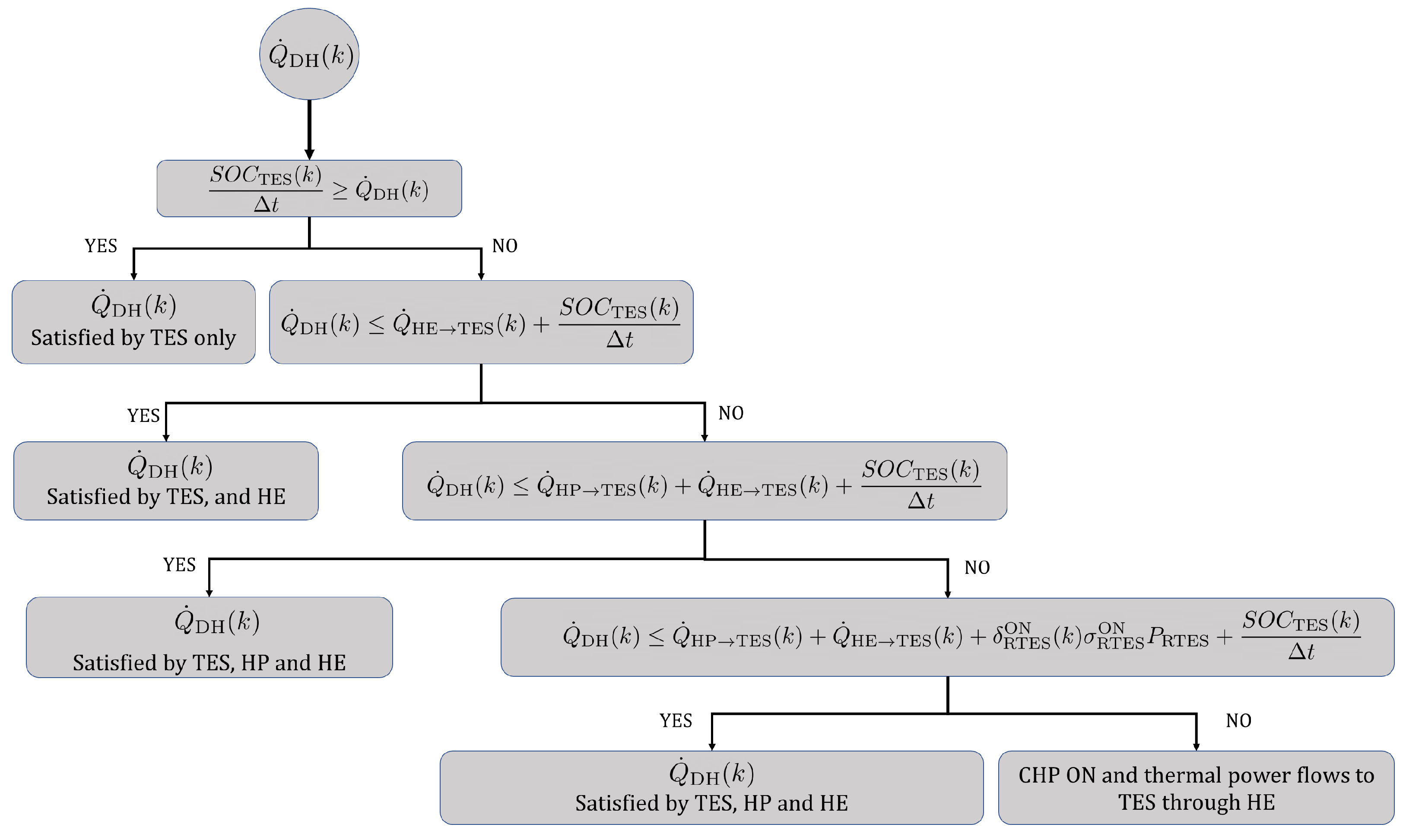


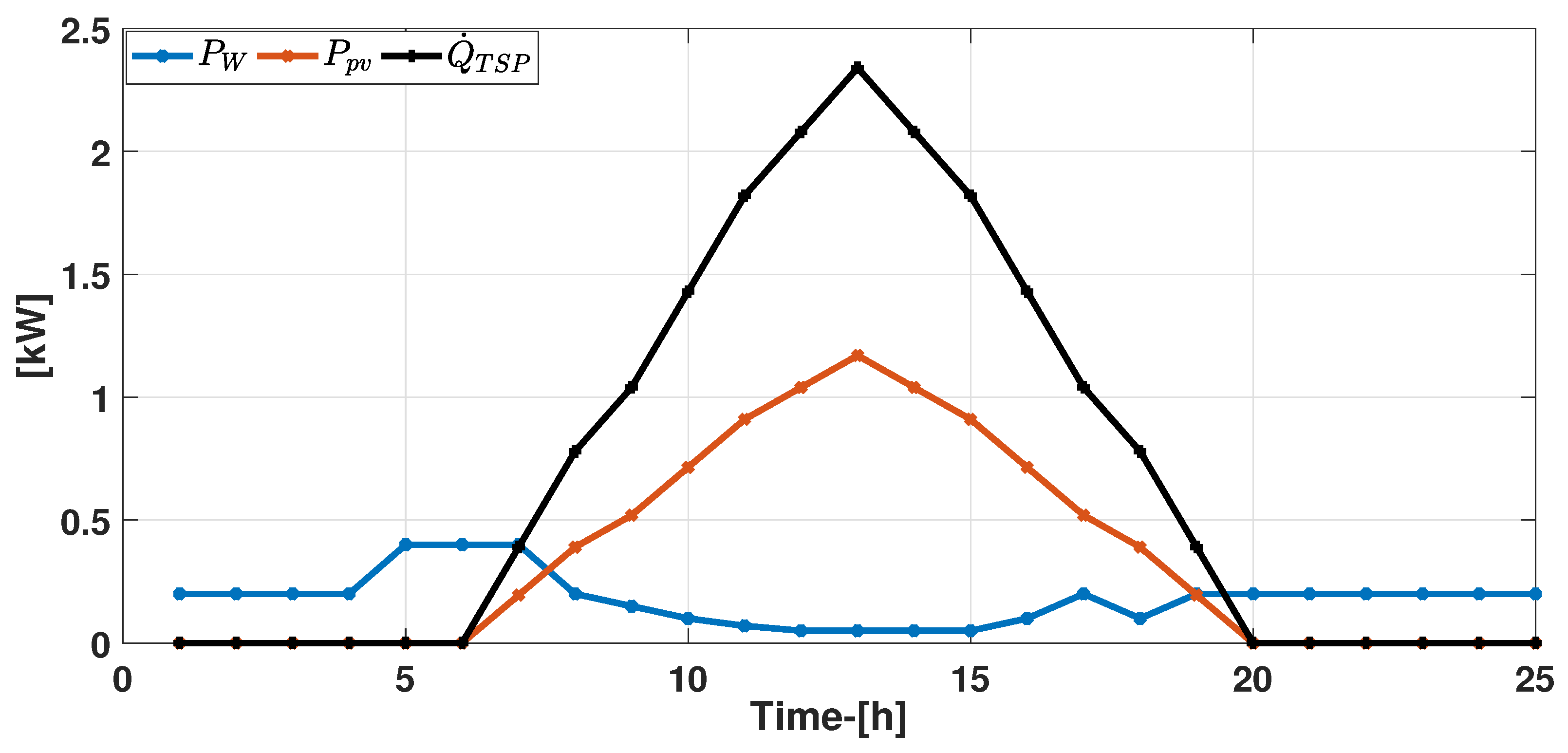
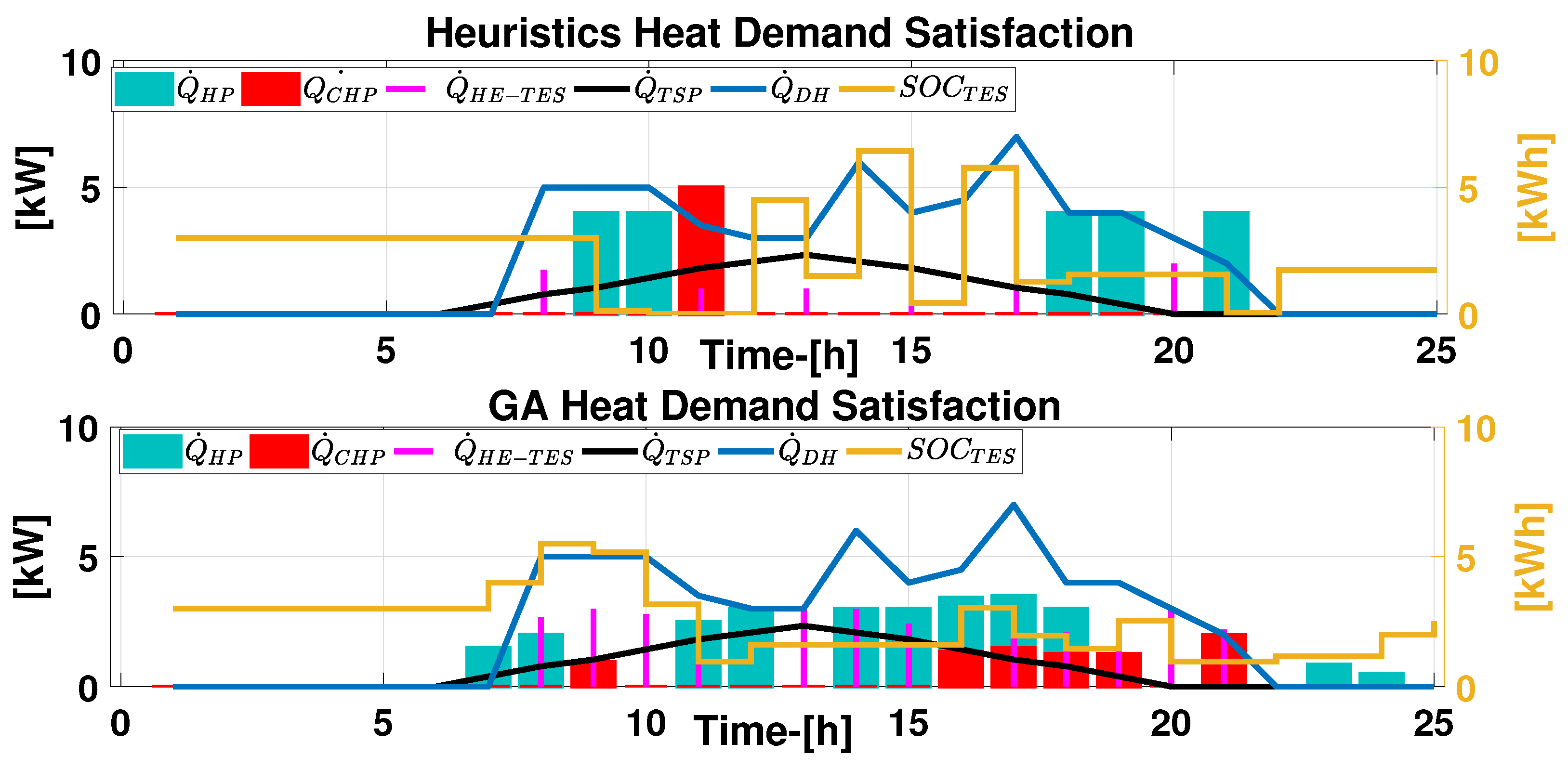
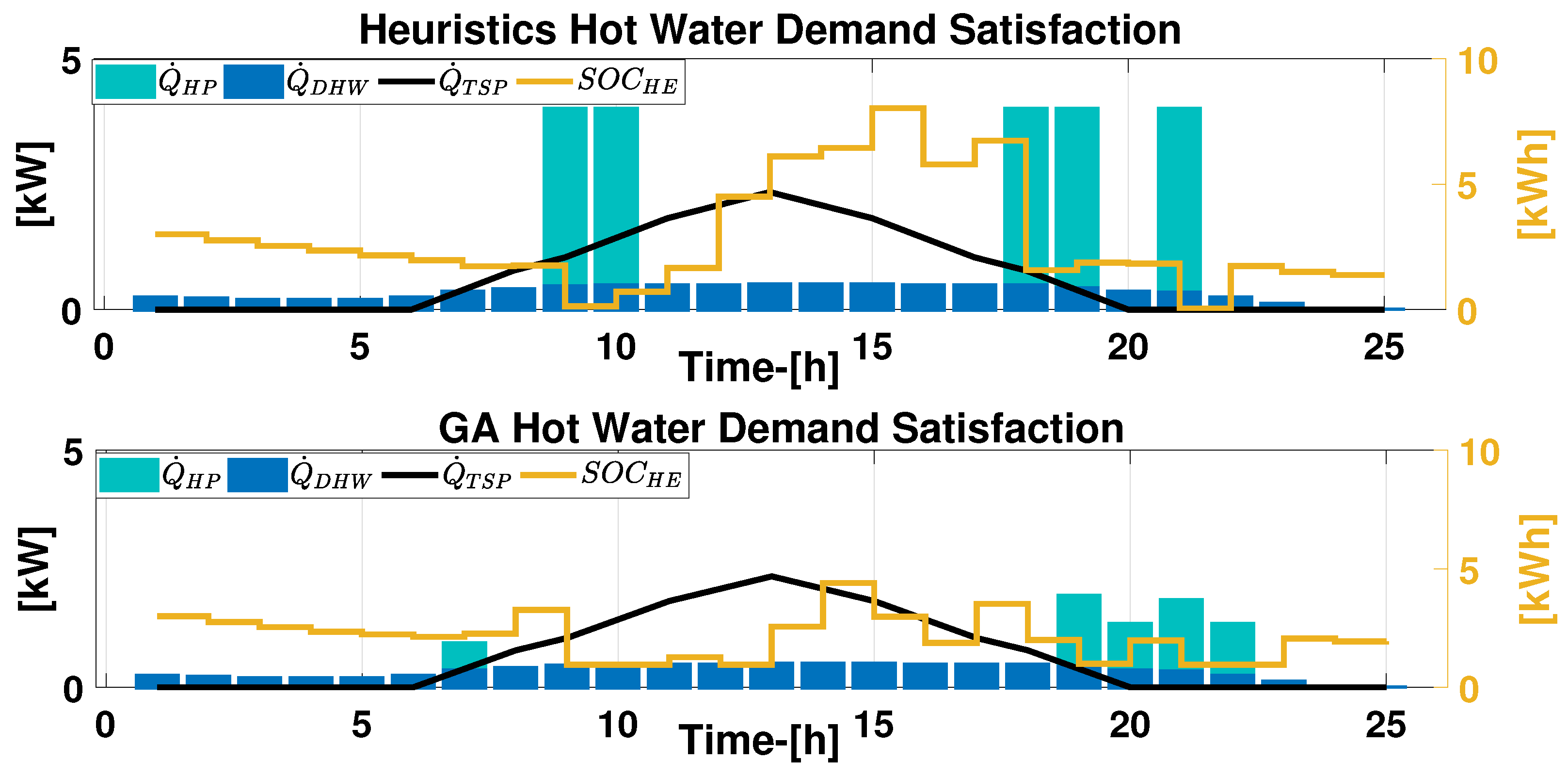

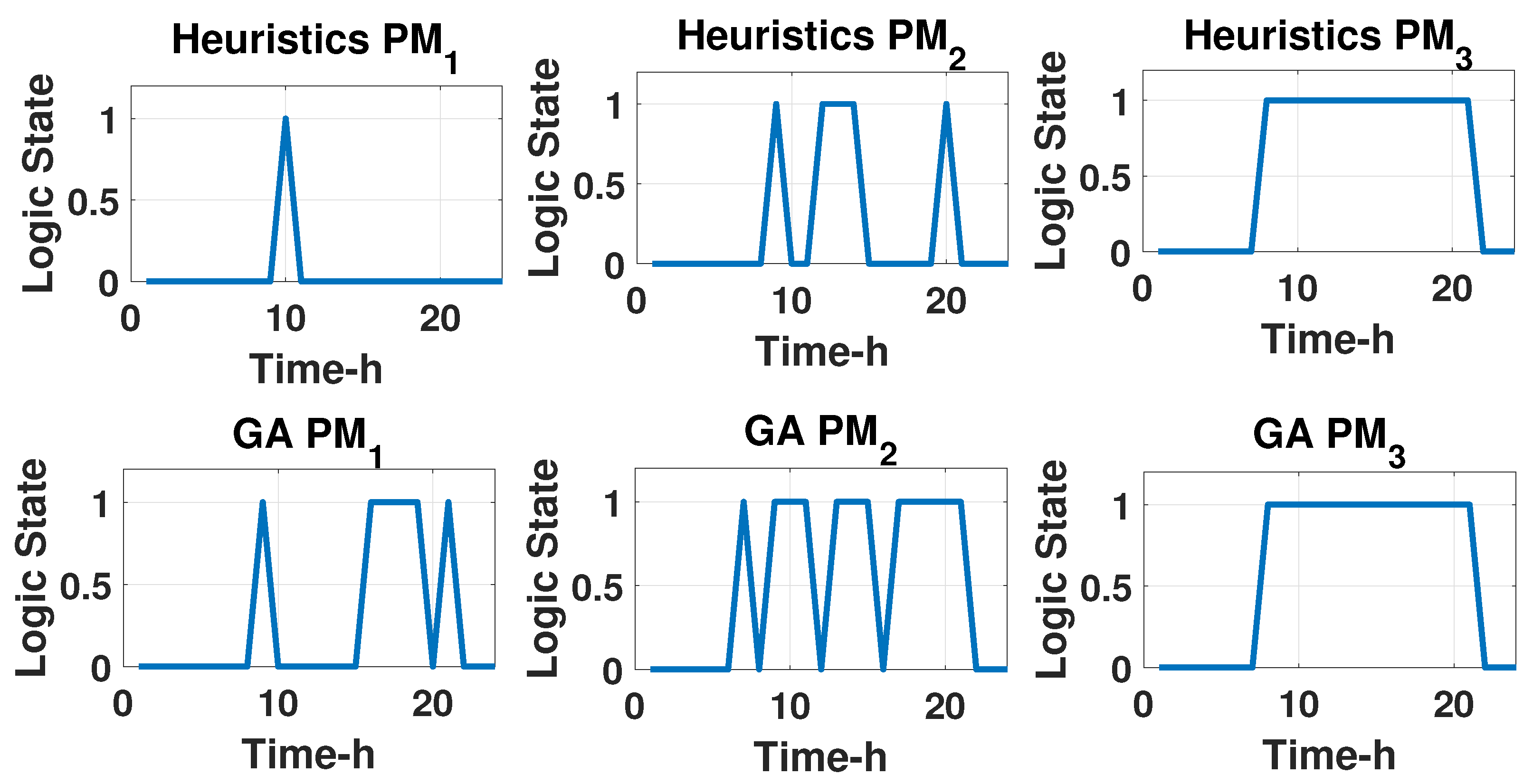

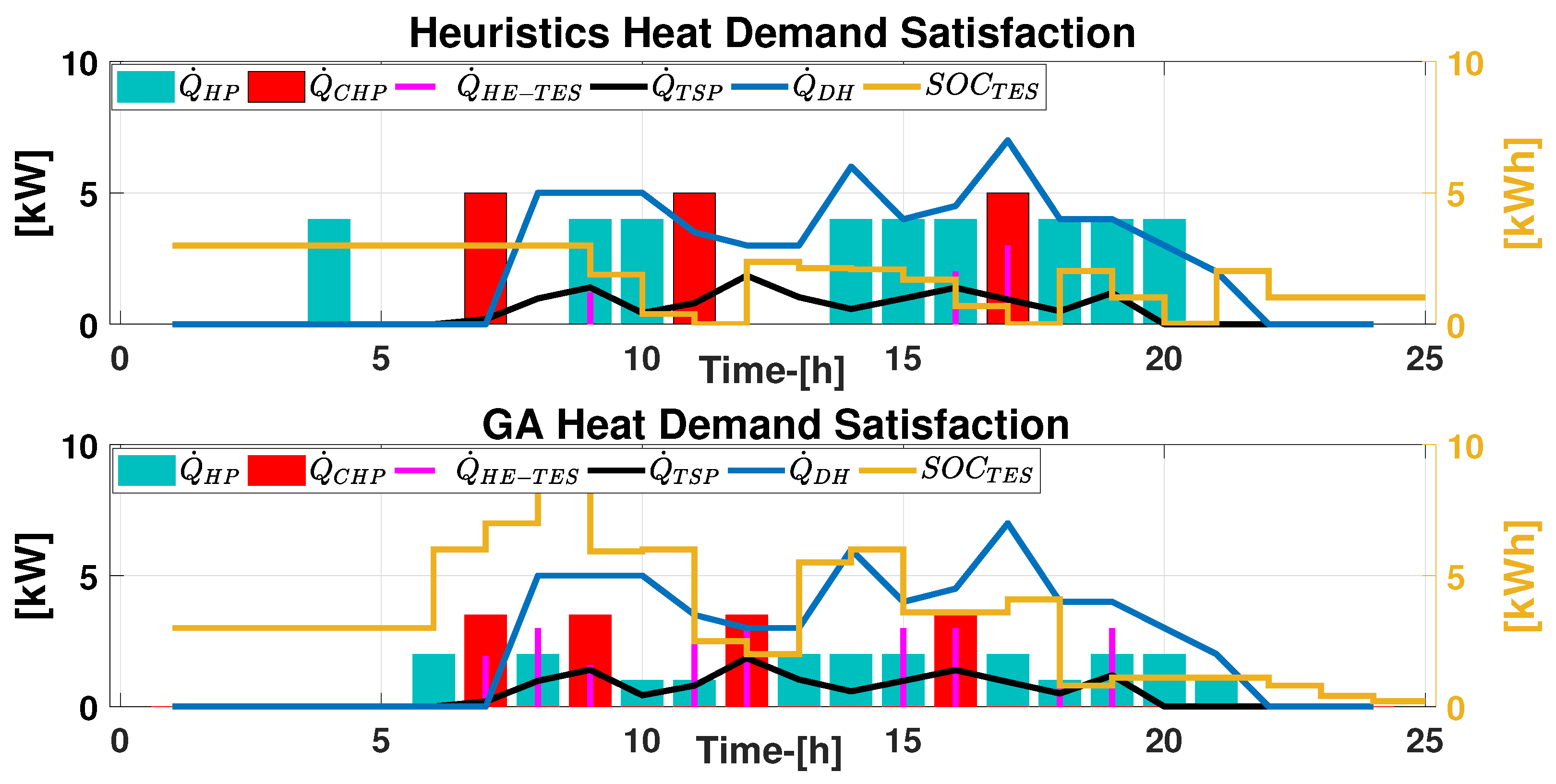

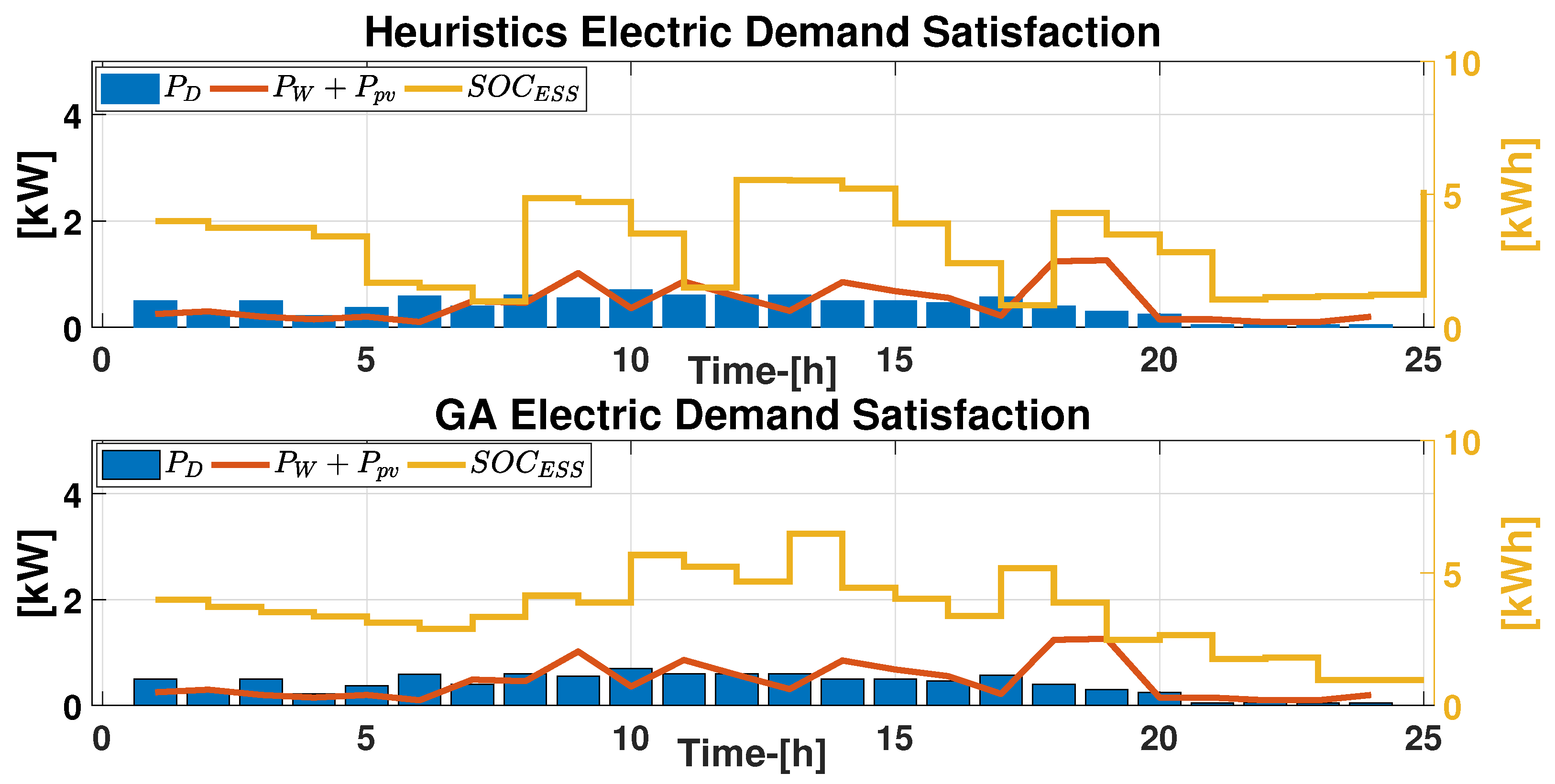



| Parameters | Description |
|---|---|
| Sampling time [ ] | |
| ON-OFF state of the nano co-generation unit (CHP) | |
| ON-OFF state of the heat pump (HP) | |
| CHP Output Electrical power | |
| CHP Output thermal power [ ] | |
| Operational state of the CHP | |
| Rated power output of CHP [ ] | |
| ON-OFF state of the Water Pump 1 | |
| ON-OFF state of the Water Pump 2 | |
| ON-OFF state of the Water Pump 3 | |
| Water Pump 1 rated electrical consumption [ ] | |
| Water Pump 2 rated electrical consumption [ ] | |
| Water Pump 3 rated electrical consumption [ ] | |
| Electrical storage system (ESS) State of charge [ ] | |
| Minimum value of | |
| Minimum value of | |
| Charging efficiency of ESS | |
| Discharging efficiency of ESS | |
| ESS rated charging power [ ] | |
| ESS rated discharging power [ ] | |
| State of charge of the heat exchanger [ ] | |
| Heat pump to heat exchanger thermal power shunting [ ] | |
| Electrical power of the thermal energy storage resistor [ ] | |
| Resistor heat-power ratio | |
| Thermal power flow from heat exchanger-thermal energy storage [ ] | |
| State of charge of thermal energy system [ ] | |
| Heat pump to thermal energy storage thermal power flow [ ] | |
| ON-OFF state of the thermal energy storage resistor | |
| ON-OFF state of the heat exchanger resistor | |
| Heat-power ratio of the resistor associated with thermal energy storage | |
| Electrical power of the thermal energy storage resistor [ ] | |
| Fuel cost [ ] | |
| Heat exchanger tank volume [ ] | |
| Heat exchanger temperature [ ] | |
| Set point temperature of the heat exchanger [ ] | |
| Tank volume of the thermal energy storage [ ] | |
| Thermal energy storage temperature [ ] | |
| Set point temperature of the thermal energy storage [ ] | |
| Heat pump minimum thermal flow [ ] | |
| Heat pump maximum thermal flow [ ] | |
| Heat pump temperature [ ] | |
| Ambient temperature [ ] |
| Power Forecasts | Description |
|---|---|
| Solar power production [ ] | |
| Wind power production [ ] | |
| Electric demand [ ] |
| Forecasts | Description |
|---|---|
| Thermal solar panel production [ ] | |
| Heat demand [ ] | |
| Hot water demand [ ] |
| Table Frame No. 1 | ||||||||
| Algorithm | Values | Case 01 | Case 02 | Case 03 | Case 04 | Case 05 | Case 06 | Case 07 |
| Heuristics | Cost Value € | 3.38 | 3.78 | 5.42 | 3.42 | 4.78 | 7.22 | 3.22 |
| CPU Time (s) | 0.42 | 0.40 | 0.50 | 0.41 | 0.43 | 0.44 | 0.39 | |
| GA | Cost Value € | 2.87 | 3.12 | 4.78 | 2.87 | 3.98 | 6.87 | 2.89 |
| CPU Time (s) | 123.12 | 120.72 | 120.1 | 123.15 | 123.75 | 122.45 | 121.05 | |
| Table Frame No. 2 | ||||||||
| Algorithm | Values | Case 08 | Case 09 | Case 10 | Case 11 | Case 12 | Case 13 | Case 14 |
| Heuristics | Cost Value € | 6.98 | 10.16 | 9.27 | 8.09 | 8.27 | 9.90 | 6.94 |
| CPU Time (s) | 0.41 | 0.40 | 0.49 | 0.42 | 0.42 | 0.41 | 0.41 | |
| GA | Cost Value € | 6.68 | 9.80 | 8.79 | 8.68 | 7.87 | 9.55 | 6.47 |
| CPU Time (s) | 127.13 | 120.72 | 122.10 | 121.05 | 124.70 | 123.75 | 123.75 | |
| Table Frame No. 3 | ||||||||
| Algorithm | Values | Case 15 | Case 16 | Case 17 | Case 18 | Case 19 | Case 20 | Case 21 |
| Heuristics | Cost Value € | 7.16 | 6.16 | 6.97 | 3.13 | 4.85 | 4.77 | 5.48 |
| CPU Time (s) | 0.42 | 0.41 | 0.50 | 0.41 | 0.44 | 0.41 | 0.38 | |
| GA | Cost Value € | 7.18 | 5.75 | 7.45 | 3.80 | 4.33 | 5.12 | 5.08 |
| CPU Time (s) | 124.02 | 120.27 | 119.51 | 122.65 | 120.75 | 121.95 | 123.75 | |
| Table Frame No. 4 | ||||||||
| Algorithm | Values | Case 22 | Case 23 | Case 24 | Case 25 | Case 26 | Case 27 | Case 28 |
| Heuristics | Cost Value € | 3.38 | 6.378 | 5.41 | 6.23 | 5.42 | 3.97 | 4.43 |
| CPU Time (s) | 0.38 | 0.49 | 0.50 | 0.44 | 0.43 | 0.40 | 0.41 | |
| GA | Cost Value € | 4.07 | 6.75 | 4.88 | 6.77 | 4.98 | 3.23 | 3.82 |
| CPU Time (s) | 112.12 | 121.52 | 119.01 | 129.55 | 118.47 | 125.95 | 121.05 | |
| Table Frame No. 5 | ||||||||
| Algorithm | Values | Case 29 | Case 30 | Case 31 | Case 32 | Case 33 | Case 34 | Case 35 |
| Heuristics | Cost Value € | 4.01 | 9.43 | 7.16 | 5.27 | 5.42 | 4.78 | 4.87 |
| CPU Time (s) | 0.37 | 0.44 | 0.45 | 0.49 | 0.39 | 0.44 | 0.44 | |
| GA | Cost Value € | 4.18 | 8.75 | 6.83 | 5.83 | 4.98 | 4.93 | 5.25 |
| CPU Time (s) | 130.12 | 121.92 | 116.10 | 114.50 | 121.05 | 123.45 | 126.32 | |
| Table Frame No. 6 | ||||||||
| Algorithm | Values | Case 36 | Case 37 | Case 38 | Case 39 | Case 40 | Case 41 | Case 42 |
| Heuristics | Cost Value € | 3.11 | 4.47 | 4.77 | 5.43 | 5.22 | 6.15 | 3.97 |
| CPU Time (s) | 0.41 | 0.40 | 0.40 | 0.49 | 0.53 | 0.40 | 0.42 | |
| GA | Cost Value € | 3.43 | 4.07 | 4.23 | 5.05 | 4.87 | 6.47 | 3.43 |
| CPU Time (s) | 121.21 | 120.27 | 125.10 | 121.57 | 123.50 | 119.73 | 120.67 | |
| Table Frame No. 7 | ||||||||
| Algorithm | Values | Case 43 | Case 44 | Case 45 | Case 46 | Case 47 | Case 48 | Case 49 |
| Heuristics | Cost Value € | 6.77 | 8.39 | 6.77 | 5.93 | 8.08 | 7.54 | 5.43 |
| CPU Time (s) | 0.46 | 0.46 | 0.50 | 0.49 | 0.42 | 0.49 | 0.42 | |
| GA | Cost Value € | 5.92 | 8.89 | 6.15 | 6.83 | 6.93 | 6.96 | 5.17 |
| CPU Time (s) | 113.42 | 118.20 | 119.56 | 123.59 | 121.67 | 120.50 | 121.95 | |
Publisher’s Note: MDPI stays neutral with regard to jurisdictional claims in published maps and institutional affiliations. |
© 2021 by the authors. Licensee MDPI, Basel, Switzerland. This article is an open access article distributed under the terms and conditions of the Creative Commons Attribution (CC BY) license (http://creativecommons.org/licenses/by/4.0/).
Share and Cite
Shehzad, M.F.; Dan, M.; Mariani, V.; Srinivasan, S.; Liuzza, D.; Mongiello, C.; Saraceno, R.; Glielmo, L. A Heuristic Algorithm for Combined Heat and Power System Operation Management. Energies 2021, 14, 1588. https://doi.org/10.3390/en14061588
Shehzad MF, Dan M, Mariani V, Srinivasan S, Liuzza D, Mongiello C, Saraceno R, Glielmo L. A Heuristic Algorithm for Combined Heat and Power System Operation Management. Energies. 2021; 14(6):1588. https://doi.org/10.3390/en14061588
Chicago/Turabian StyleShehzad, Muhammad Faisal, Mainak Dan, Valerio Mariani, Seshadhri Srinivasan, Davide Liuzza, Carmine Mongiello, Roberto Saraceno, and Luigi Glielmo. 2021. "A Heuristic Algorithm for Combined Heat and Power System Operation Management" Energies 14, no. 6: 1588. https://doi.org/10.3390/en14061588
APA StyleShehzad, M. F., Dan, M., Mariani, V., Srinivasan, S., Liuzza, D., Mongiello, C., Saraceno, R., & Glielmo, L. (2021). A Heuristic Algorithm for Combined Heat and Power System Operation Management. Energies, 14(6), 1588. https://doi.org/10.3390/en14061588







